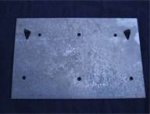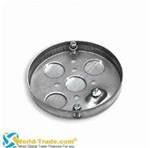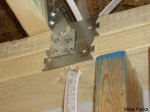A local combo inspector recently turned down an inspection on 2 new houses because, the deep Carlon plastic boxes are too close to the surface of the wall on the backside. He wants them all nail plated. My interpritation of the code on this is, when the NM is running through the stud it needs to be plated, but when it is on the side of the stud there is no need to nail plate it. I thought Carlon had addresssed this issue before, does anyone have info on that? This has delayed the completion of the houses for no good reason, I have yet to see any job where this has been required. Any helpful comments would be welcome.
You are using an out of date browser. It may not display this or other websites correctly.
You should upgrade or use an alternative browser.
You should upgrade or use an alternative browser.
Nail plate the back of a plastic box ???? Really???
- Thread starter acrwc10
- Start date
- Status
- Not open for further replies.
kwired
Electron manager
- Location
- NE Nebraska
- Occupation
- EC
Cables on side of studs need to be kept 1-1/4" from edge of stud or otherwise be protected from penetration by nails, screws, etc.
That said, he is asking you to protect a box and not a cable.
That said, he is asking you to protect a box and not a cable.
Cables on side of studs need to be kept 1-1/4" from edge of stud or otherwise be protected from penetration by nails, screws, etc.
That said, he is asking you to protect a box and not a cable.
This is where it gets "questionable" where the NM goes into the box (factory KO's) it is closer than 1 1/4". I have yet to see ONE job in 34 years where this was required, my oppinion is it is personal and I see no place for that in his job.
What does he think will be nailed into the box? A picture? I guess the inspector has never seen a screw ran through the breaker panel from the meterbase.
That being said, is he also requiring you to install nail plates to the backside of the breaker panel, or is it surface mounted...I know, it is metal.
That being said, is he also requiring you to install nail plates to the backside of the breaker panel, or is it surface mounted...I know, it is metal.
kwired
Electron manager
- Location
- NE Nebraska
- Occupation
- EC
This is where it gets "questionable" where the NM goes into the box (factory KO's) it is closer than 1 1/4". I have yet to see ONE job in 34 years where this was required, my oppinion is it is personal and I see no place for that in his job.
I understand that also, have never been giged for it, is also a little hard to win either side of that argument. The main idea of keeping cables 1-1/4 from edges of studs is so nails or screws securing the wall finish will not damage cable if they miss the stud. I do try to keep cables as far away as practical when entering these boxes, and can not recall ever having to fix a damaged cable in this area in about 25 years, so I would say the chance of damage is pretty slim.
What does he think will be nailed into the box? A picture? I guess the inspector has never seen a screw ran through the breaker panel from the meterbase.
That being said, is he also requiring you to install nail plates to the backside of the breaker panel, or is it surface mounted...I know, it is metal.
The biggest problem is the back side of wall from where the outlet box opening is. I have occasionally seen nails or screws penetrate a box, as well as a panelboard. The guy installing the meter on back side should know better, especially after doing it once before. I have run into that problem more often when other items are mounted back side of where panel is. Seen screws for hanging shelves, cabinets, etc on back side of wall penetrate anything you can imagine inside wall, even seen kitchen cabinets supported by plumbing in wall instead of studs.
Strathead
Senior Member
- Location
- Ocala, Florida, USA
- Occupation
- Electrician/Estimator/Project Manager/Superintendent
This is where it gets "questionable" where the NM goes into the box (factory KO's) it is closer than 1 1/4". I have yet to see ONE job in 34 years where this was required, my oppinion is it is personal and I see no place for that in his job.
I thought that at first, then I read 300.4(D) It doesn't say cables attached to studs, it says cables run parrallel to... So I am of the opinion that if the inspector can put a tape measure on the edge of the stud and measure less than 1 1/4" (as the crow flies) to the romex, or even MC, then he is properly executing the exact wording of the NEC. Whether others have picked this up in the past or not.
kwired
Electron manager
- Location
- NE Nebraska
- Occupation
- EC
I thought that at first, then I read 300.4(D) It doesn't say cables attached to studs, it says cables run parrallel to... So I am of the opinion that if the inspector can put a tape measure on the edge of the stud and measure less than 1 1/4" (as the crow flies) to the romex, or even MC, then he is properly executing the exact wording of the NEC. Whether others have picked this up in the past or not.
That could possibly mean don't use the cable opening in the box that is right next to the stud. I kind of have no problem with that logic, but like I said before - never been asked to change these, and can not recall ever having an incident where cable was damaged in over 25 years, so I think the risk is very small if you do use that cable opening.
Sierrasparky
Senior Member
- Location
- USA
- Occupation
- Electrician ,contractor
Dangerous damage should be picked up by an ARC fault .Yes!
The drywaller should know there is a box near the stud.
The drywaller should know there is a box near the stud.
- Location
- New Jersey
- Occupation
- Journeyman Electrician (retired)
Cables on side of studs need to be kept 1-1/4" from edge of stud or otherwise be protected from penetration by nails, screws, etc.
That said, he is asking you to protect a box and not a cable.
IMO the inspector is thinking the same thing. Bogus but enforceable by the wording of the NEC unless you enter the box KO at least 1.25" away from the stud.
- Location
- Chapel Hill, NC
- Occupation
- Retired Electrical Contractor
I have heard other inspectors require this but it is pretty lame.
readydave8
re member
- Location
- Clarkesville, Georgia
- Occupation
- electrician
If drywallers were half that sharp it would sure cut down on the time I've spent looking for buried boxes.Dangerous damage should be picked up by an ARC fault .Yes!
The drywaller should know there is a box near the stud.
kwired
Electron manager
- Location
- NE Nebraska
- Occupation
- EC
Dangerous damage should be picked up by an ARC fault .Yes!
The drywaller should know there is a box near the stud.
The problem is on the back side not the side with the box opening. When they are driving nails/screws next to the cut out they know exactly where the box is. When they are hanging opposite side of wall there is no cut out and they have no idea the box is there if they miss the stud with nail/screw, and the cable also enters the box closer to that side of the wall.
construct
Senior Member
- Location
- Branson, Missouri
my oppinion is it is personal and I see no place for that in his job.
Agreed.
jxofaltrds
Retired ESI
- Location
- Mike P. Columbus Ohio
- Occupation
- Creator
A local combo inspector recently turned down an inspection on 2 new houses because, the deep Carlon plastic boxes are too close to the surface of the wall on the backside. He wants them all nail plated. My interpritation of the code on this is, when the NM is running through the stud it needs to be plated, but when it is on the side of the stud there is no need to nail plate it. I thought Carlon had addresssed this issue before, does anyone have info on that? This has delayed the completion of the houses for no good reason, I have yet to see any job where this has been required. Any helpful comments would be welcome.
He is correct and you must also install one of these over the front of the box.

IMO the inspector is thinking the same thing. Bogus but enforceable by the wording of the NEC unless you enter the box KO at least 1.25" away from the stud.
Both bogus and NOT in the NEC. You would never be able to enter a outlet.
Ask him how a nail or screw can enter the face of a stud then enter the back of a box. Does he still believe in the magic bullet? (Kennedy for you younins)
(D) Cables and Raceways Parallel to Framing Members
and Furring Strips. In both exposed and concealed
locations, where a cable- or raceway-type wiring method is
installed parallel to framing members, such as joists,
rafters, or studs, or is installed parallel to furring strips, the
cable or raceway shall be installed and supported so that the
nearest outside surface of the cable or raceway is not less
than 32 mm (11⁄4 in.) from the nearest edge of the framing
member or furring strips where nails or screws are likely to
penetrate. Where this distance cannot be maintained, the
cable or raceway shall be protected from penetration by
nails or screws by a steel plate, sleeve, or equivalent at least
1.6 mm (1⁄16 in.) thick.
- Location
- New Jersey
- Occupation
- Journeyman Electrician (retired)
He is correct and you must also install one of these over the front of the box.
View attachment 7253
Both bogus and NOT in the NEC. You would never be able to enter a outlet.
Ask him how a nail or screw can enter the face of a stud then enter the back of a box. Does he still believe in the magic bullet? (Kennedy for you younins)
(D) Cables and Raceways Parallel to Framing Members
and Furring Strips. In both exposed and concealed
locations, where a cable- or raceway-type wiring method is
installed parallel to framing members, such as joists,
rafters, or studs, or is installed parallel to furring strips, the
cable or raceway shall be installed and supported so that the
nearest outside surface of the cable or raceway is not less
than 32 mm (11⁄4 in.) from the nearest edge of the framing
member or furring strips where nails or screws are likely to
penetrate. Where this distance cannot be maintained, the
cable or raceway shall be protected from penetration by
nails or screws by a steel plate, sleeve, or equivalent at least
1.6 mm (1⁄16 in.) thick.
You're reading that section incorrectly. If the cable is secured at least 1.25" from the face of the stud and enters the box in a KO at least 1.25" from the stud then it's code complaint.
jxofaltrds
Retired ESI
- Location
- Mike P. Columbus Ohio
- Occupation
- Creator
You're reading that section incorrectly. If the cable is secured at least 1.25" from the face of the stud and enters the box in a KO at least 1.25" from the stud then it's code complaint.
Disagree. If it is 1/8th of an inch away from the stud it is no longer parallel to the stud.
So tell me how to use this box?

kwired
Electron manager
- Location
- NE Nebraska
- Occupation
- EC
That box the cable enters the back wall which is your protection from screws or nails that are securing drywall or other wall finishing material.Disagree. If it is 1/8th of an inch away from the stud it is no longer parallel to the stud.
So tell me how to use this box?
View attachment 7254
Parallel to stud? Is'nt the next stud 14-1/2 inches away also parallel to the stud in question? If so why is a cable 1/8 inch away not parallel? It is certainly much closer to parallel than it is to perpendicular.:happyyes:
Ive been through the same issues before.I have also had siding nails shot through into the bus bar on a few load centers too.We normally make up the breaker panel on the rough.But, as of late we wait until the final .We remove the interior from the box too.I have seen closet shelf hanger scews driven into the breaker box too.
jxofaltrds
Retired ESI
- Location
- Mike P. Columbus Ohio
- Occupation
- Creator
That box the cable enters the back wall which is your protection from screws or nails that are securing drywall or other wall finishing material.
Parallel to stud? Is'nt the next stud 14-1/2 inches away also parallel to the stud in question? If so why is a cable 1/8 inch away not parallel? It is certainly much closer to parallel than it is to perpendicular.:happyyes:
It enters the box within 1 1/4" of the edge of the stud or joist.
It says "installed" parallel. That means where it is attached.
Ive been through the same issues before.I have also had siding nails shot through into the bus bar on a few load centers too.We normally make up the breaker panel on the rough.But, as of late we wait until the final .We remove the interior from the box too.I have seen closet shelf hanger scews driven into the breaker box too.
Not my job to protect from stupid. Yes the nails went through the wires.

- Status
- Not open for further replies.

